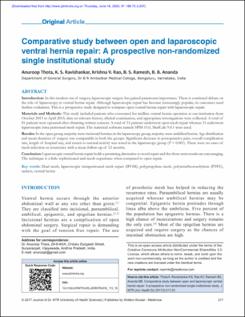| dc.contributor.author | Thota, Anuroop | |
| dc.contributor.author | Ravishankar, KS | |
| dc.contributor.author | Rao, Krishna V | |
| dc.contributor.author | Ramesh, BS | |
| dc.contributor.author | Ananda, BB | |
| dc.date.accessioned | 2020-06-18T19:35:01Z | |
| dc.date.available | 2020-06-18T19:35:01Z | |
| dc.date.issued | 2017-10-01 | |
| dc.identifier.other | 10.4103/JDRNTRUHS.JDRNTRUHS_115_16 | |
| dc.identifier.uri | http://repositorio-indicasat.org.pa/handle/123456789/95 | |
| dc.description | Introduction: In this modern era of surgery, laparoscopic surgery has gained paramount importance. There is continued debate on the role of laparoscopy in ventral hernia repair. Although laparoscopic repair has become increasingly popular, its outcomes need further evaluation. This is a prospective study designed to compare open ventral hernia repair with laparoscopic repair.
Materials and Methods: This study included patients who consented for midline ventral hernia operation at our institution from October 2013 to April 2015; data on relevant history, clinical examination, and appropriate investigations were collected. A total of 81 patients were operated after obtaining written consent. A total of 51 patients underwent open mesh repair whereas 31 underwent laparoscopic intra peritoneal mesh repair. The statistical software namely SPSS 15.0, MedCalc 9.0.1 were used.
Results: In the open group, majority were incisional hernias; in the laparoscopy group, majority were umbilical hernia. Age distribution and mean duration of surgery was comparable in both the groups. Significant decrease in postoperative pain, overall complication rate, length of hospital stay, and return to normal activity was noted in the laparoscopy group (P < 0.001). There were no cases of mesh infection or recurrence with a mean follow-up of 12 months.
Conclusion: Laparoscopic ventral hernia repair holds a promising alternative to novel repair and the short-term results are encouraging. The technique is a little sophisticated and needs experience when compared to open repair. | en_US |
| dc.description.abstract | Introduction: In this modern era of surgery, laparoscopic surgery has gained paramount importance. There is continued debate on the role of laparoscopy in ventral hernia repair. Although laparoscopic repair has become increasingly popular, its outcomes need further evaluation. This is a prospective study designed to compare open ventral hernia repair with laparoscopic repair.
Materials and Methods: This study included patients who consented for midline ventral hernia operation at our institution from October 2013 to April 2015; data on relevant history, clinical examination, and appropriate investigations were collected. A total of 81 patients were operated after obtaining written consent. A total of 51 patients underwent open mesh repair whereas 31 underwent laparoscopic intra peritoneal mesh repair. The statistical software namely SPSS 15.0, MedCalc 9.0.1 were used.
Results: In the open group, majority were incisional hernias; in the laparoscopy group, majority were umbilical hernia. Age distribution and mean duration of surgery was comparable in both the groups. Significant decrease in postoperative pain, overall complication rate, length of hospital stay, and return to normal activity was noted in the laparoscopy group (P < 0.001). There were no cases of mesh infection or recurrence with a mean follow-up of 12 months.
Conclusion: Laparoscopic ventral hernia repair holds a promising alternative to novel repair and the short-term results are encouraging. The technique is a little sophisticated and needs experience when compared to open repair. | en_US |
| dc.language.iso | en | en_US |
| dc.subject | Dual mesh | en_US |
| dc.subject | laparoscopic intraperitoneal mesh repair (IPOM) | en_US |
| dc.subject | polypropylene mesh | en_US |
| dc.subject | polytetrafluoroethylene (PTFE) | en_US |
| dc.subject | tackers | en_US |
| dc.subject | ventral hernia | en_US |
| dc.title | Comparative study between open and laparoscopic ventral hernia repair: A prospective non-randomized single institutional study | en_US |
| dc.type | Article | en_US |

